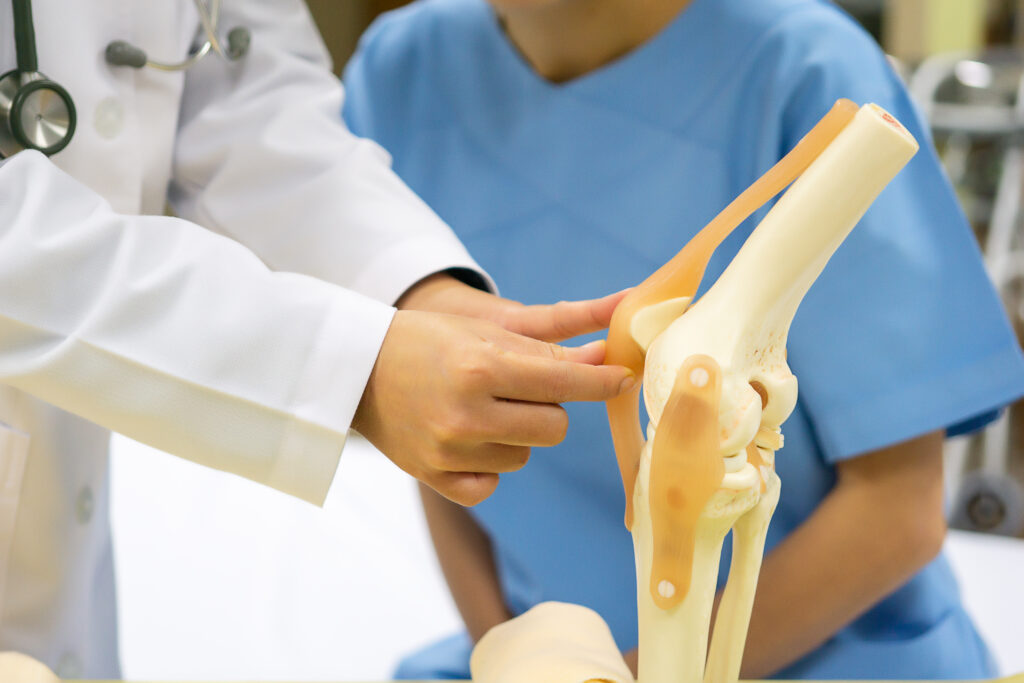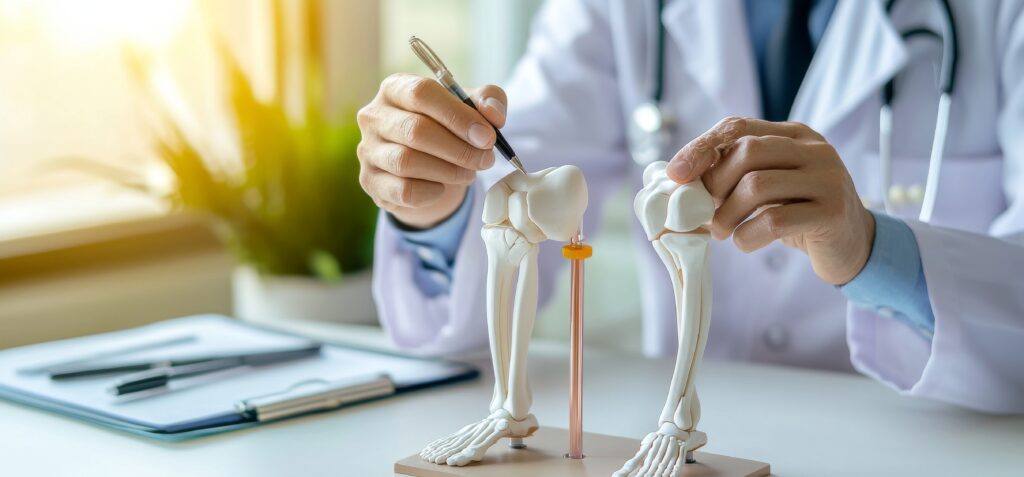ARTHROSCOPY
BEST ARTHROSCOPIC SURGEON IN CHANDIGARH- DR. VIKAS MEHRA
What is Arthroscopy?
Arthroscopy is a minimally invasive surgical procedure used to diagnose and treat joint problems. It involves inserting a small camera, called an arthroscope, into the joint through tiny incisions. This allows the surgeon to get a clear, detailed view of the joint and perform necessary treatments with precision.
This procedure is commonly used for knee, shoulder, hip, elbow, and ankle joints to treat conditions like ligament injuries, cartilage damage, and joint inflammation. Since arthroscopy requires only small incisions, it leads to less pain, faster recovery, and minimal scarring compared to traditional open surgery.
Dr. Vikas Mehra, recognized as the Best Arthroscopic Surgeon in Chandigarh, specializes in performing advanced arthroscopic procedures with high success rates. With his expertise, patients experience quick healing, improved joint function, and a smooth return to daily activities.

Benefits of Arthroscopy
Arthroscopy is a minimally invasive surgical procedure used to diagnose and treat joint problems. It offers several advantages over traditional open surgery, making it a preferred choice for many patients. Dr. Vikas Mehra, recognized as the Best Arthroscopic Surgeon in Chandigarh, specializes in advanced arthroscopic procedures, ensuring quicker recovery and better outcomes.
1. Minimally Invasive Procedure
2. Faster Recovery Time
3. Reduced Risk of Complications
4. Less Pain & Medication Requirement
5. Improved Joint Function & Mobility

Why Choose Dr. Vikas Mehra?
Choosing Dr. Vikas Mehra for arthroscopy ensures that you receive expert care from one of the Best Arthroscopic Surgeons in Chandigarh. With years of experience, advanced knowledge, and a patient-centered approach, Dr. Mehra excels in providing minimally invasive arthroscopic procedures that promote quicker recovery and reduced pain. His meticulous attention to detail and use of state-of-the-art technology guarantee optimal outcomes for patients. From personalized treatment plans to post-surgery rehabilitation, Dr. Mehra ensures a smooth and effective recovery process. His compassionate care, combined with a proven track record of successful surgeries, makes him the ideal choice for those seeking expert arthroscopic treatment.
Arthroscopic Procedures Performed by Dr. Vikas Mehra, The best Arthoscopic surgeon in Chandigarh
Arthroscopy is a minimally invasive procedure used to treat a variety of joint problems, offering quicker recovery, less pain, and better outcomes than traditional surgery. Dr. Vikas Mehra, recognized as the Best Arthroscopic Surgeon in Chandigarh, specializes in a wide range of arthroscopic procedures. With his expertise, he helps patients regain mobility, reduce pain, and improve their overall quality of life. Below are some of the most common arthroscopic procedures performed by Dr. Vikas Mehra:
1. Knee Arthroscopy
Knee problems like ligament tears, cartilage damage, or inflammation can significantly affect mobility and cause chronic pain. Knee arthroscopy is a procedure where small incisions are made to insert a camera and surgical instruments into the knee joint. This allows Dr. Mehra to diagnose and treat conditions like:
- Meniscal tears
- Ligament reconstruction
- Cartilage repair
- Knee joint cleaning (debridement)
2. Shoulder Arthroscopy
Shoulder issues such as rotator cuff tears, shoulder instability, and arthritis can be effectively treated using shoulder arthroscopy. This procedure helps diagnose and treat:
- Rotator cuff repairs
- Shoulder labrum tears
- Shoulder impingement
- Joint inflammation treatment
Dr. Vikas Mehra’s expertise in shoulder arthroscopy ensures minimal disruption to surrounding tissues, leading to a faster recovery.
3. Hip Arthroscopy
Hip pain caused by conditions like labral tears, arthritis, or hip impingement can significantly affect daily activities. With hip arthroscopy, Dr. Mehra performs precise treatments such as:
- Labral tear repair
- Cartilage restoration
- Hip joint debridement
Hip arthroscopy offers patients a less invasive option for managing hip joint problems and promoting quicker recovery.
4. Ankle Arthroscopy
For patients suffering from ankle injuries like ligament damage or chronic inflammation, ankle arthroscopy provides a way to access the joint without major surgery. Dr. Mehra treats:
- Ankle ligament reconstruction
- Removal of bone spurs or scar tissue
- Treatment for tendon injuries
5. Wrist Arthroscopy
Wrist pain can arise from ligament injuries, arthritis, or fractures. Using wrist arthroscopy, Dr. Mehra can perform repairs and remove damaged tissue or bone fragments with minimal incisions. Common treatments include:
- Ligament reconstruction
- Debridement of damaged tissue
- Fracture repair
Wrist arthroscopy can relieve pain and restore normal wrist function.
6. Elbow Arthroscopy
For conditions like tennis elbow or joint stiffness, elbow arthroscopy is an effective treatment option. This procedure is used for:
- Elbow tendon repair
- Joint cleaning and debridement
- Removal of bone spurs or damaged cartilage
Why Dr. Vikas Mehra is the Best Arthroscopic Surgeon in Chandigarh?
When it comes to joint pain, injuries, and arthroscopic procedures, Dr. Vikas Mehra is recognized as the Best Arthroscopic Surgeon in Chandigarh. With years of experience, specialized training, and a compassionate approach to patient care, he stands out as a leader in the field of orthopedics and arthroscopy. Here’s why Dr. Mehra is the preferred choice for patients seeking expert arthroscopic care:
Expertise and Experience
He has done post-graduation (MS) from the prestigious PGI Chandigarh, Diplomate of National Board in Orthopedics, and fellowship in joint replacement from the top centers of North America.He carries over 30 years of experience.
Personalized Treatment
Developing individualized care about what it will take to resolve your situation completely or partially, he formulates a treatment plan that fits your circumstance.
Advanced Technology
Most of the procedures that Dr. Mehra performs are lavishly equipped with advanced technology and pin-point dexterity – minimal invasive procedures, therefore, causing little discomfort to the patient and much shorter recovery time.
Complete Care
What more is that from the time you set foot in the hospital, to the time you are discharged after perhaps surgery, Dr. Mehra and his team are fully involved in ensuring that the services run smoothly.
Global Expertise
Dr. Mehra has working experience in most of the developed nations renowned medical facilities thus facilitating assimilation of the best practices in healthcare in Chandigarh.
Positive Patient Outcomes
Dr. Vikas Mehra ensures positive outcomes with pain relief and improved mobility, offering personalized care for quick recovery.
If you’re looking for the Best Arthroscopic Surgeon in Chandigarh, Dr. Vikas Mehra offers expertise, advanced technology, personalized care, and a proven track record of success. His focus on minimally invasive procedures ensures that you can regain your quality of life with minimal discomfort and downtime. Whether you’re dealing with knee pain, shoulder injuries, or joint problems, Dr. Mehra’s skills can help you find relief and restore mobility, getting you back to the activities you love.
+91-9814612696
+91-9876044747
Plot No 1501, Sector 33d, Chandigarh
Monday to Friday - 9:30am-8:30pm Saturday- 9am-3pm, Sunday - Closed
